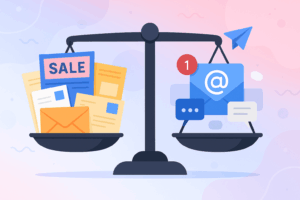Chasing new buyers is often at the top of retailers’ agendas. But as acquisition costs skyrocket in a competitive online market, retention is becoming increasingly vital. A loyal customer base is no longer a nice-to-have- it’s the fuel for sustainable success.
The challenge is working out which channel cuts through and keeps buyers coming back. Direct mail is often dismissed as email’s forerunner, unable to keep up in the digital sprint- but is this assumption keeping your re-engagement rates at walking pace?
In this post, we’ll break down the facts to take the guesswork out of your retention strategy.
The Initial Hurdle: Open and Response Rates
Getting noticed is the first step in any marketing campaign. If customers don’t engage, your exclusive offers and tailored messaging are a wasted effort.
Here email stumbles. Today’s consumers are flooded with communication across digital channels. As inboxes crowd with promotions and new releases, attention spans wear thin: open rates sit at 20-30%, while average response trails at 1-3%.
While digital communication has snowballed, physical post has become a novelty- the average household receives 30% less mail compared to a decade ago. This not only creates visibility- with 90% open rates across the UK- but drives incentive to engage. At 7.2%, warm direct mail’s average response doubles that of email (JICMAIL). Paperplanes’ data-driven campaigns, meanwhile, consistently lap this benchmark: partnering with us to re-incentivise lapsed customers, Pets Love Fresh enjoyed 27% conversion rates.
Email will get you off the line quickly, but incorporating a tangible channel may be the key to pulling ahead in the race for customers’ attention.
Honing Your Approach: Personalisation
Tailored marketing maximises your chance of driving a repeat purchase, and here digital channels wield obvious power. Email marketing has been integrating with CRM systems for decades, pulling customer data in real-time to create the impression of one-to-one communication- even while contacting thousands.
Post isn’t left in the dust here, however. Today’s programmatic mail enables the channel to match emails’ pace – both in precision and scale. At Paperplanes, for example, we connect your CRM, marketing automation platform, and mail vendor’s API to automate behaviour-triggered, data-driven mailings. Combining the precision of digital targeting with the impact of tangible formats, modern mail is a customer loyalty powerhouse: TALA Light’s customers were 20% more likely to return after receiving our personalised winback mailers.
When it comes to a bespoke experience, the channels are neck and neck.
The Winning Finish: Cost and Return On Investment
Faced with narrowing budgets, email can seem like the more attractive athlete- costing just a few pennies per recipient. Meanwhile, the design and postage expenses of mail may tempt marketers to keep it on the bench.
But customer retention is a marathon, not a sprint. While email promises low up-front costs, direct mail’s results reflect its higher investment. Royal Mail’s study reveals that customers feel more valued when they receive physical post- fostering deeper connections that yield stronger impacts. Case-in-point: Paperplanes’ mailers see average order value increases as high as 54%.
Conclusion: The Relay Advantage
So, which channel takes the finish?
Email’s speed and cost-effective conversions are unignorable. With engagement rates stuck at the starting blocks, however, relying on digital alone means leaving half the crowd behind.
The real winning move is realizing that email and direct mail aren’t opponents: they’re teammates. Email excels in early re-engagement efforts, building consideration and keeping your brand top-of-mind. Leveraging post provides a second wind, delivering the premium, high-impact touchpoint necessary to seal conversions. Embedding Paperplanes’ direct mail within a multi-touchpoint strategy, Mattressman found that mailed customers were 233% more likely to convert than non-mailed cohorts- in fierce e-commerce landscape, combining email and direct mail forges the iron-clad brand connections necessary for strong retention.
Want to know how to incorporate direct mail seamlessly into your marketing strategy? Let’s chat.




